Collagen is one of the most discussed dietary supplements in sports and health today. The promise: healthier joints, more stable tendons, and more resilient ligaments. The question for athletes, trainers, and coaches is whether these effects are scientifically proven.
Osteoarthritis affects over 57 million people in Western Europe alone (1). At the same time, connective tissue injuries (e.g., to tendons and ligaments) are the most common sports injuries. Collagen plays a central role here, as it is the structural protein of the extracellular matrix in tendons, cartilage, and ligaments. Therefore, it is plausible that an improvement in collagen synthesis can indirectly lead to better quality of joints and connective tissue and reduce the risk of injury (2).
This Article Analyzes and Summarizes the Effectiveness of Collagen Supplementation on Joint and Tendon Health.
Collagen, Gelatin, and Amino Acids: Fundamentals
Collagen is a protein structure composed of amino acids. In contrast to muscle tissue, it contains fewer essential amino acids and more of the non-essential amino acids proline and glycine.
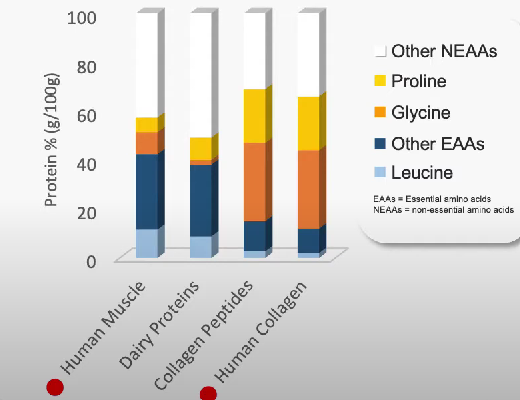
This leads to the hypothesis that the intake of collagen hydrolysate or gelatin, which contain high amounts of proline and glycine, could potentially exert an anabolic stimulus on the rate of collagen synthesis.
Gelatin and Collagen
Gelatin and collagen have a comparatively low biological value. Accordingly, they are not good nutrients to support muscle growth. For instance, new studies have not been able to identify a positive effect of collagen supplementation on muscle protein synthesis (4). However, this does not automatically mean that they cannot have positive effects on other tissues. For example, studies have shown that the contained peptides reach the target tissue (5).
How well are gelatin and collagen absorbed?
Early animal studies showed that gelatin hydrolysate is absorbed by the organism and incorporated into cartilage tissue (6). These findings were later confirmed in human studies: In a study with eight healthy subjects, the intake of 15 g of vitamin C-enriched gelatin significantly increased the concentrations of glycine and proline in the blood, suggesting improved availability for collagen synthesis (7).
The researchers also observed an increased PINP concentration (Procollagen Type-I N-terminal Propeptide) – an indirect blood marker for collagen synthesis. These results indicate that gelatin and collagen are indeed incorporated into the synthesis processes.
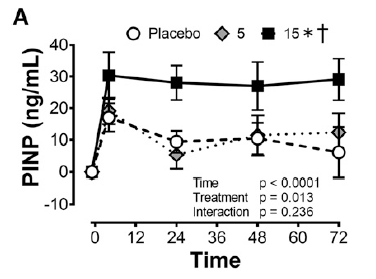
Collagen synthesis rate measured via PINP, with 0, 5 and 15g of Gelatine – Vitamin-C enriched (7)
Collagen Supplementation: Current Research and Effectiveness
The same research group conducted a follow-up study comparing the effect of 15 g of hydrolyzed collagen with 15 g of gelatin (enriched with vitamin C) and gummy bears containing both gelatin and collagen (8).
The Results
Both collagen and gelatin (enriched with vitamin C) supplementation led to an increase in collagen synthesis rate of approximately 20%, which was, however, not statistically significant. A closer look at individual participants also reveals a large individual variance: upon closer examination of the individual data, the overall positive effect appears likely to be due to a positive outlier – in both the gelatin and collagen groups. In fact, no positive change in collagen synthesis rate was measured in 3 of the 8 participants in the gelatin group, and no effect was observed in 4 of the 8 participants in the gelatin group. 
Therefore, it is Questionable whether these Positive Findings Can be Transferred to the General Population.
More recent studies also show mixed results. Two studies (9, 10) observed increased collagen synthesis with collagen supplementation compared to a placebo, while another study (11) found no effect. The reason for the lack of effect in the latter study is unclear to me, as all three studies were conducted under very similar conditions. I think we need to wait for more data before we can make a more accurate assessment of efficacy.
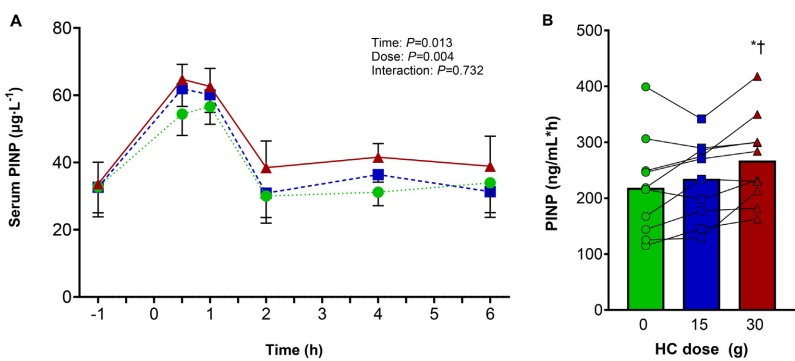
Indirect measurement of collagen synthesis via serum PINP levels (10).
The Major Problem of Study Quality
It is also worth mentioning that an artificial ligament was used in both studies. So far, there are no human studies that confirm these results—which is also not methodologically possible at present. Therefore, in my opinion, further studies with larger cohorts are needed before we can say with certainty that supplementation with gelatin or collagen has a positive effect on collagen synthesis.
The problematic aspect of mechanistic studies that measure collagen synthesis via the blood marker PINP is that while it can indicate an increased activation of collagen-rich tissue synthesis, we do not know WHERE this process is precisely occurring. In addition to tendons, ligaments, and cartilage, collagen is also found in the skin, bones, and muscles. Consequently, it is not known whether an elevated PINP value necessarily leads to improved growth of tendons, ligaments, or cartilage tissue.
PINP is merely an indirect blood marker for collagen synthesis and provides no indication of what is actually happening in tendon or cartilage tissue.
However, there are other studies we can examine to better assess the overall effect on joint and ligament health. For example, McLindon and colleagues (12) investigated the effect of daily supplementation with 10 g of collagen hydrolysate on mild knee osteoarthritis over a period of 48 weeks. The long study duration is definitely a major advantage. The researchers also assessed cartilage function using dGEMRIC images, which is a much better indicator of changes in cartilage tissue than measuring acute synthesis rates over a short period (13, 14). And indeed, a positive effect is clearly visible when looking at the following images:
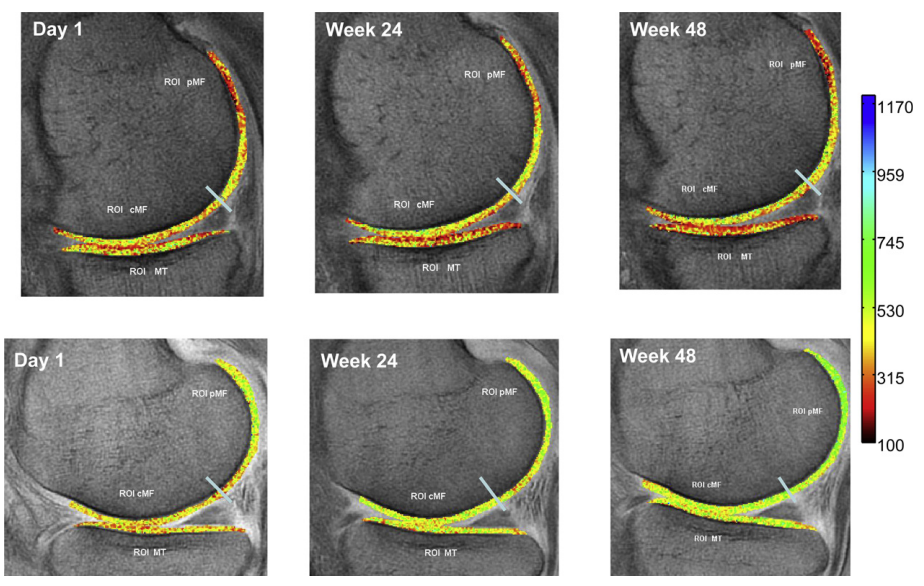
the bottom photo series is from the collagen group, where more green indicates more cartilage mass
Is this Proof that Collagen Supplementation is Actually Effective in Improving Cartilage Damage?
Caution, Details are Important!
The dGEMRIC images used showed improvements in cartilage in the posterior lateral femoral region, with the collagen group demonstrating a statistically better improvement than the control group. However, further MRI scans of cartilage tissue in other regions (medial tibia, central mid-femur, posterior medial femur, lateral tibia, central lateral femur) showed no differences between the collagen and placebo groups. This could, for example, be attributed to less movement/activation of these joints – but ultimately, this is just a speculation. Without further information, the influence of training is difficult to assess. Ultimately, it remains unclear why the collagen group showed improvement in certain areas but no change in others.
The authors’ conclusion is:
In contrast to the dGEMRIC results, T2 cartilage measurements showed little variability or change over time and no differences in any region between the groups […] due to the pilot nature of this study and its small sample size, we do not consider these results definitive, and the CH intervention warrants further testing in a larger study.
Collagen: Influence on the Stiffness and Functionality of Tendons and Ligaments
In the same study (15), changes in physical performance and tendon stiffness were also investigated—but without positive effects from collagen supplementation. Since the participants did not complete any targeted strength or resistance training, this could explain the lack of effect. McAlindon et al. (2011) (12) already emphasized that resistance training is a central stimulus for collagen synthesis (16).
Leet et al. (2003), on the other hand, observed slight benefits of daily supplementation with 30 g of collagen hydrolysate plus 500 mg of vitamin C on the stiffness of the patellar tendon in female soccer players [COL +18.0% vs. PLA +5.1%; p = 0.049], with no differences in tendon growth (13).
In another study, 40 young men trained their calf muscle and Achilles tendon in a structured manner for 14 weeks, supplemented with 5 g of collagen peptides (Temdeforte®) per day (17). This led to a significantly greater increase in tendon cross-sectional area (+11.0% vs. +4.7%; p = 0.002), but without differences in tendon stiffness or muscle strength.
Praes et al. (2019) used a similar protocol: In a double-blind cross-over study with ten participants with Achilles tendinitis, taking 2.5 g of collagen peptides over six months in combination with calf strength training showed no significant improvements in tendon structure, ankle function, or pain symptoms (18). Although there was a trend towards a faster return to sport, this was not statistically significant. In other words, we do not know whether the observed differences are due to chance or whether they are actually the result of CP intake.
Interestingly, this study is still often cited as evidence for the effectiveness of collagen peptides—even though it could not demonstrate any significant effects on tendon health or regeneration in athletes.
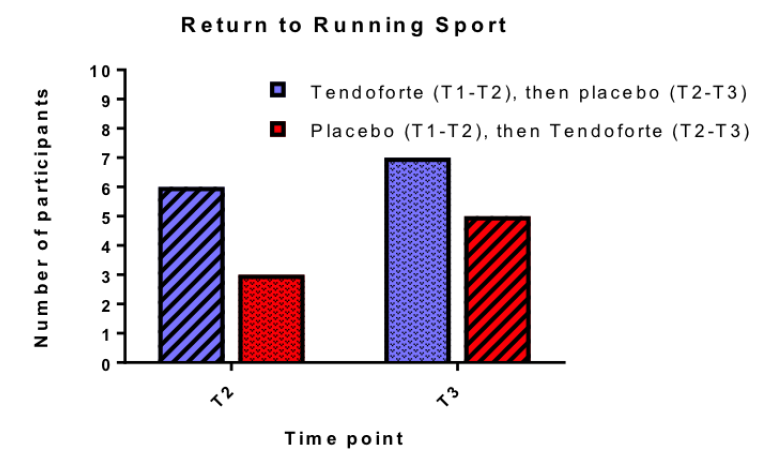
Praet et al., (2019): no statistical analysis due to the small number of subjects
Pain-Relieving Effect?
Several studies have indeed observed a reduction in pain perception due to arthritis (19,20,21). Improvement was noted not only in the patients’ subjective pain perception but was also confirmed by a physician’s measurements and tests. Depending on the study, pain perception improved by 10-25%. However, it should also be mentioned that there are studies that found no improvement (22).
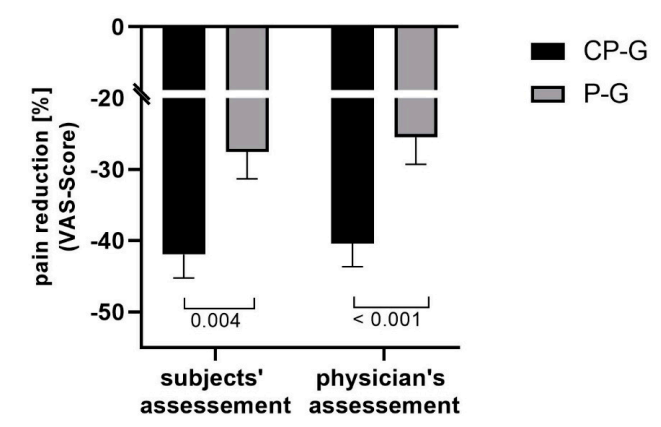
Relative change in subjective pain perception (VAS Score)
(19)
Recommend Collagen for Pain: Yes or No?
A 10% pain reduction is not particularly significant. A 25% reduction in perceived pain, however, is quite a substantial improvement. Ultimately, one does not know which category they fall into until they have tried it for several weeks. This means: individuals suffering from chronic pain due to cartilage damage can certainly try collagen for 8 weeks in combination with a rehabilitation program to see if a positive effect can be observed.
Positive Effect of Whey and Casein?
It is reasonable to assume that high-quality protein sources such as whey or casein protein could promote collagen synthesis. Surprisingly, however, several studies show no positive effects of whey protein on intramuscular connective tissue or the rate of collagen synthesis (23, 24). A possible explanation is that whey protein is metabolized too quickly, while the activation of connective tissue occurs with a delay – which is why a more slowly absorbed protein might better stimulate synthesis.
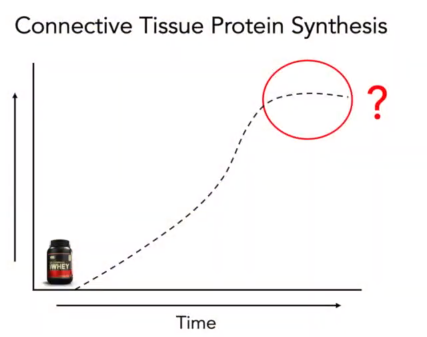
Source: Nutrition Tactics
This hypothesis was investigated by Trommelen et al. (2020): While training itself increased the connective tissue synthesis rate, an additional intake of 30 g of casein protein after endurance training provided no further benefit (25). Connective tissue proteins contain particularly high amounts of proline (12%) and glycine (25%) compared to muscle proteins – two key amino acids for collagen synthesis. Casein, however, contains only about 6.5% proline and 2% glycine, which is presumably insufficient to effectively increase connective tissue protein synthesis (26). This assumption is supported by the observation that casein intake in the study by Trommelen et al. (2020) could not increase blood glycine concentration.
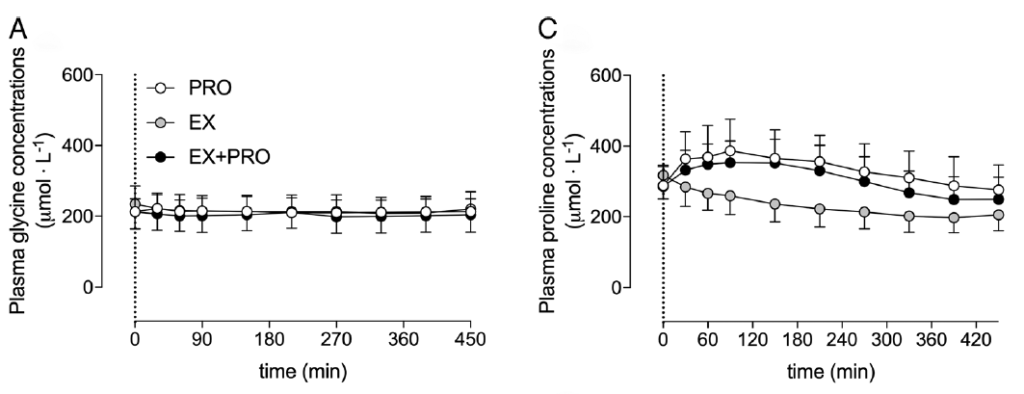
Changes in blood glycine and proline concentrations after intake of 30g of casein (Trommelen et al., 2020)
What happens with higher amounts of protein?
This question was investigated in a follow-up study by the same researchers (27): In this study, older subjects consumed 40g of casein after resistance training.
we show for the first time that amino acids from dietary proteins are incorporated into new cartilage tissue in older adults
And Indeed, a Positive Effect on the Synthesis Rate of Cartilage Tissue Was Observed. However, a possible effect on collagen synthesis was not measured here. Unfortunately, due to the study design, we cannot specifically deduce whether the positive effect was caused by exercise and casein supplementation.
Special collagen needs for women?
In women, hormonal influences play an important role in collagen metabolism. Estrogen may potentially influence this process, as estrogen receptors have been detected in tendon tissue (27). This leads to the hypothesis that fluctuations in estrogen levels during the menstrual cycle could alter the mechanical properties of connective tissue, such as elasticity, stability, and regenerative capacity (28).
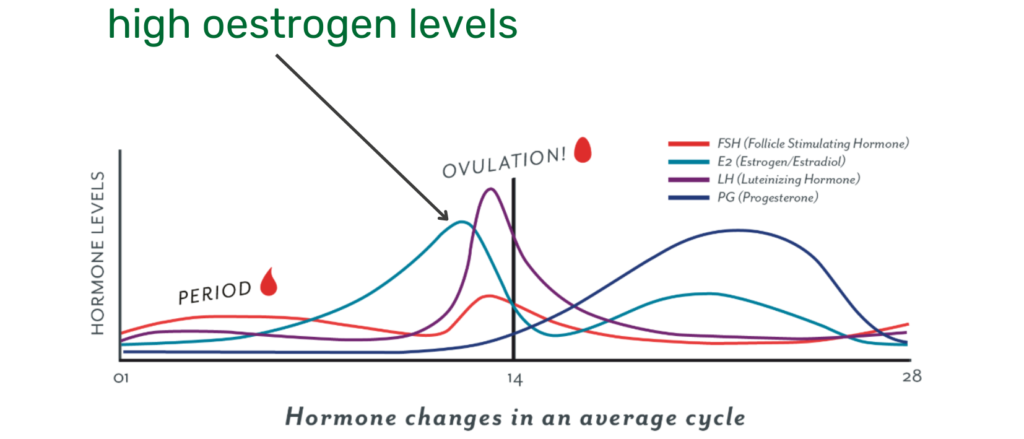
To date, only one case study has investigated the influence of estrogen on collagen synthesis. Researchers determined estrogen levels at various points in a CrossFit athlete’s menstrual cycle and examined whether collagen intake influences exercise-induced collagen synthesis (29). As expected, estrogen levels were highest at the end of the follicular phase – just before ovulation. During this phase, a reduced exercise-induced collagen synthesis rate was observed, measured by the blood marker PINP. However, consuming 30 g of collagen before training partially mitigated this negative effect. Naturally, larger-scale studies are needed to confirm the observation in a single athlete.
Summary:
- Mechanistic in vitro studies show that collagen and gelatin could have a significant positive influence on cartilage synthesis rates.
- In patients with chronic joint pain, continuous collagen supplementation for 8 weeks or longer can improve subjective pain levels by ~10 to 25%.
- Currently, the evidence for improving cartilage health is rather weak.
- The effectiveness of collagen on tendon stiffness appears to be somewhat better. Whether this truly prevents injuries or reduces recovery time is still unclear.
- It appears that both whey and casein protein have no significant effect on cartilage tissue, even when consumed in larger quantities.
- We still lack high-quality human RCTs to draw definitive conclusions about the potential positive effects of collagen supplementation on joint and tendon health.
Our Assessment
- Overall, the research is quite inconsistent; some studies show promising results.
- However, upon closer examination of the details of these studies, almost all of them exhibit methodological weaknesses.
- The results of mechanistic studies, as well as the positive outcomes regarding pain reduction, are somewhat promising.
- However, we need more high-quality human RCTs to draw more definitive conclusions. As of: July 2025
Evidence for Improving Cartilage, Tendon, and Ligament Health 
